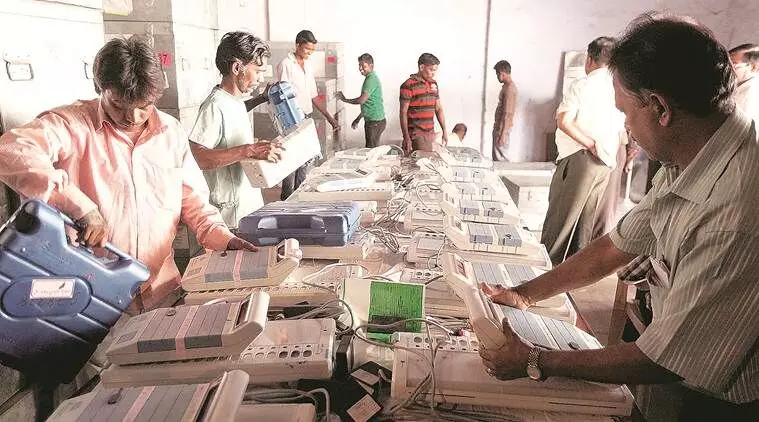Ballot boxes to EVMs: Incredible journey of Election Commission indelibly inked in history
The ECI headquartered at Nirvachan Sadan in Delhi, is now gearing up to hold the 2024 Lok Sabha polls
By Newsmeter Network
New Delhi: Born a day before India became a republic, the Election Commission has evolved a lot in the last 75 years from the period of ballot boxes to the era of electronic voting machines with democracy being the beating heart of this electoral machinery.
Since its inception on January 25, 1950, the Commission has conducted 17 general elections, numerous assembly polls and elections to the offices of presidents and vice presidents.
The Election Commission of India (ECI), headquartered at Nirvachan Sadan in Delhi, is now gearing up to hold the 2024 Lok Sabha polls, whose schedule is likely to be announced in March.
A lot has changed from the first general elections conducted in India after Independence in 1951-52 to the 2019 Lok Sabha polls. The country, its electorate and technology have evolved a lot and so has the ECI.
Former chief election commissioner S Y Quraishi said the Indian election, given the sheer scale and magnitude of preparations over the years, is now considered "a gold standard".
Sukumar Sen, an ICS officer who served as the chief secretary of West Bengal, was appointed as the first Chief Election Commissioner (CEC) of India. He assumed charge on March 21, 1950, nearly two months after the ECI was set up. Both the first and the second general elections in 1957 were conducted with him at the helm of electoral affairs.
Quraishi, who was the 17th CEC, described Sen as an "unsung hero" of India's electoral journey. Not much has been documented about his life, legacy and the seminal role he played in setting the tone for Indian elections, Quraishi said.
"I have no inhibition in saying that nearly 80 per of what we do today (as an Election Commission) is what he had started. We are carrying it forward. And, thumbs up to the Commission and its role over the years," he told PTI.
While independent India held its first elections in 1951-52 with steel ballot boxes for 489 seats to the House of the People, electronic voting machines (EVMs) conceived in the late 70s, were first used in an assembly poll in 1998 and expanded to a chunk of parliamentary constituencies in 1999.
According to the ECI website, more than a million EVMs were used in all 543 parliamentary constituencies in the country in the 2004 general elections.
In these 75 years, the Election Commission, starting from the maiden election that was dubbed the 'great experiment', has overcome many challenges -- demographic, geographic and logistical -- with innovative thinking to make the electoral process easier and more accessible for voters.
It brought the 'symbol system' in the 1952-52 polls during which 27,527 booths across the country were reserved for women. In the following decades, the ECI brought facilities such as ramps and wheelchairs for persons with disability, Braille voter slips, EVMs with Braille signage, the reintroduction of electoral photo identity cards and using digitised photos in line with its maxim -- "Leaving no voter behind".
The ECI has leveraged digital technology to develop various mobile applications such as 'cVigil', besides aiming to make the election process more transparent, accountable and inclusive.
Navin Chawla, the 16th CEC of India, in his book, "Every Vote Counts: The Story of India's Elections" writes that the commission continued to "derive enormous advantage by being amongst the first electoral management bodies worldwide to embrace technology so comprehensively".
He termed the use of EVMs a "bold idea" that would transform the manner in which polls were conducted.
However, there has been criticism from a few quarters in the past few years, especially during elections, over issues linked with the functioning of EVMs at some polling stations.
Quraishi, who authored 'An Undocumented Wonder: The Making of the Great Indian Election', said the poll panel should be "more open and defend themselves if there is any criticism and call a press conference to respond to criticisms."
Praising the colossal work performed by the ECI in the conduct of elections, he lamented that "marginal issues" or some issue reported with a few EVMs often became central, which subsumes the larger picture of the execution of this mammoth exercise.
Occasionally, the ECI faced logistical issues in some constituencies due to a very large number of candidates. But every time it has responded to such challenges and ensured the due electoral process through innovative solutions, a former senior official of the poll panel told PTI.
Voter Verifiable Paper Audit Trail (VVPAT) was introduced to improve transparency and verifiability in the poll process after the Conduct of Election Rules, 1961, were amended and notified in August 2013. The option of 'None of the Above' (NOTA) vote was introduced in the 2014 Lok Sabha polls.
While the maiden polls had 173 million electors, the size of the electorate grew to 911.9 million in the 2019 general elections which saw a record turnout of 67.4 per cent.
Former CEC Nasim Zaidi, in a foreword in 'Election Atlas of India' published in 2017, writes that the ECI "enjoys trust and confidence of people of the country for delivering regular, periodic, credible and acceptable elections every time and on time since 1952".